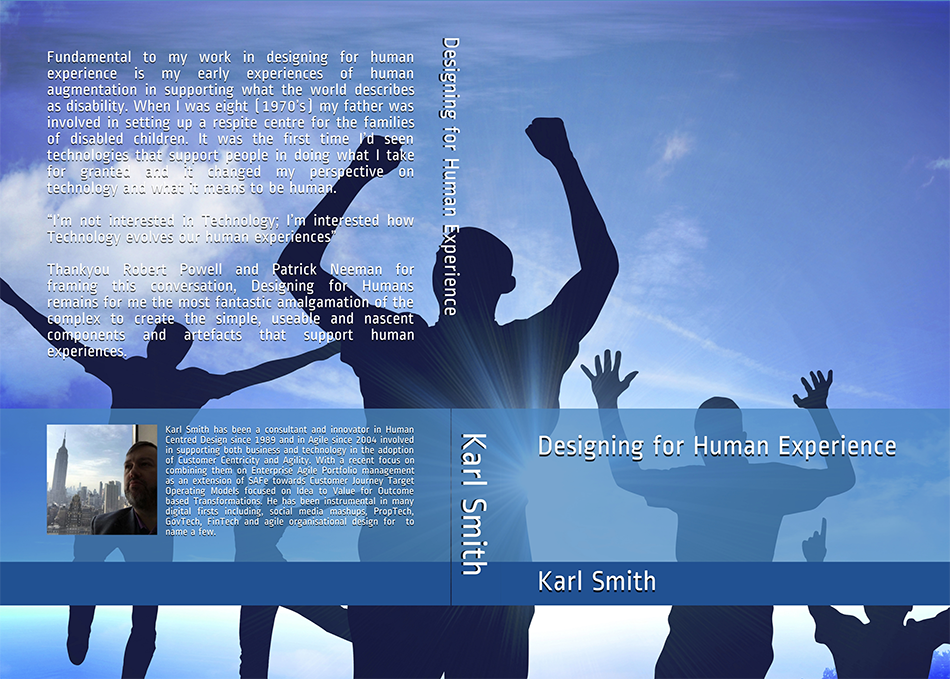
The Author
Karl Smith (1966 to present) was born in Kent, to Irish immigrants, grew up in Beckenham and currently lives in Scotland. He has worked globally (USA, Europe, South America, China, India, Australia) as a consultant for corporations, governments and startups, always looking for the next impossible challenge. He has focused his life on problem solving, to fix the everyday problems of humans. He is an avid learner and polymath from St Joseph's College, Beulah Hill to Ravensbourne College of Art and Design in Chislehurst, Middlesex University at Cat Hill and later Napier University in Edinburgh his knowledge sits across design, engineering, science and the humanities. He is best known in the fields of User Experience (UX), Human Centred Design (HCD), Organisational Agility, Agility and Scaled Agile but also works in Technology Architecture, Infrastructure, Networking, IoT, Blockchain and Artificial Intelligence.
In this his first Polymath book he describes what it means to design for humans, the various roles involved, the errors, pitfalls and agendas that cause work to fail and how he responded to them.
Excerpt - Designing for Human Experience Glossary
It is important before getting into the main part of this book to understand aspects of motivation and rationale across the wide area of specialisations I have worked in over the years hence the glossary of roles, often the same words and phrases are used to mean different things. It’s like being told someone speaks English so communication will be easy, all the while not realising that meaning is biographical through culture and geography. Definitely make notes on things you don’t agree with and please contact me on LinkedIn if you’d like to chat https://www.linkedin.com/in/karlsmith2/
This is a short glossary to cover the now myriad of terminology related to designing for humans. I expect there to be more as time goes on humans do seem to love reinventing the wheel and then renaming it.
designing for
TDP – the design process
IA – information architecture
CA – content author
PD – product design
ID – instructional design
U – usability
A – accessibility
UX – user experience
UXS – user experience strategy
CX – customer experience
UCD – user centered design
HCD – human centred design
SD – service design
DT – design thinking
ST – systems thinking
PX – pervasive experience
IoT – internet of things
DT – digital transformation
AT – agile transformation
OD – organisational design
SA – scaled agile
BA – business agility
human experience
Excerpt - Definition of User Experience (UX)
Philosophy of UX
User experience is about making people's lives better not just changed. A person’s experience is based in their mind and their emotions and can be established by both actual interaction and reflective (biographical experience) inputs. In UX we define inputs in digital or real-world frameworks which enable the creation of solutions that have meaningful impact and that can be measured.
Overview of UX
The current approach to UX is that it is the practical implementation of audience drivers, cognitive acuity, usability standards and accessibility laws with ergonomics (physical, contextual use) and anthropometric (digital behaviours analytics) measures. Creating an integration of business context into user context, to facilitate alignment, transactions and communications.
Definition; A user is a representative of the target audience. They are not involved in the project in any way. They will use the final product or service either as a customer or as an internal business user.
UX is not involved in the Look and Feel associated with GUI's but rather delivers the human solution that can be accessed through any user interface this is why UX is closely associated with assistive technologies used in accessibility which are in turn derivatives of technologies developed for the military and space exploration. While UX is not rocket science, it has been involved in the space program
Excerpt - Indications of flawed or doctored research results
There are a number of other pointers to work out if your results have been skewed to fit a perspective or project politic.
“Everyone said the same thing about their experience”
This is statistically impossible, they could say a similar thing, the exact same thing is a fix to match a personal agenda or a perspective.
“We got very positive feedback”
This is impossible, feedback by its very nature is both positive and negative, both are critical to get a balanced view and essential so that the project is refined to deliver the intended outcomes.
“We passed usability testing at 95%”
This is impossible, usability testing is not a pass or a fail. Usability testing is designed to find faults and is conducted throughout the project not just at the end. If there was a success factor for usability testing it would be to find lots of faults in time for them to be corrected.
Watch out for these and others as you gain experience.
Designing for Human Experience Book
USA - https://www.amazon.com/Karl-Smith/e/B08LMMZC6D?
UK - https://www.amazon.co.uk/Karl-Smith/e/B08LMMZC6D?
Excerpt - How do you design experience UX Design?
You can design a framework or architecture but the experience in UX is in someone's mind and in their emotions, if you design people’s experience it’s a crime against humanity.
UX research or UX analysis all make lots of sense but UX design does not, but the real point here is the breaking of the UX process into sections. The practice of breaking the process is clearly done by people who don’t understand it.
I keep meeting UX researchers who are excited that I am recruiting UX people, but to me not being able to do the full process creates too many limitations on them as viable UX people. Apart from the obvious inability to pass critical information at role breaks;
why should my clients pay for limited people with one component when a holistic UX person can cover the whole process?
UX research involves quantitive and qualitive research. Researching existing data to look for patterns and anomalies to express the problem or conducting simple but mass sample research needs to be validated by the intended users. In a simple way quantitive research tells you what and qualitive data tell you why. It is important to not rely on quantitive data (insights) alone as without the context of qualitive data (meaning) it is common to make decisions based on bias rather than customer’s needs. This is the major problem with AI as it is currently designed and utilised.
UX facilitation and research is the fun part and everyone wants to do it, analysis is quite complex if it happens at all, but converting the concepts from the analysis into features and behaviour is the critical component which is the design (solutions) part of the process.
Defining the interactive framework and delivering it through sitemaps, journey maps, wireframes or interactive modelling is an architectural activity as it relates to creating multiple routes that enable different kinds of users to acquire information, products or services. UX does not do graphic design, get a Graphic Designer (this is a highly skilled role separate from UX) for that and avoid anyone who says they can do both because they are divergent mental models, so they won't be highly skilled in both.
Experience cannot be designed you can only open access points to having an experience.
Experience is personal to the user, so UX Designers do not exist (except as created by recruiters or clients without knowledge).
Due out November 2020
E-Book: ISBN 978–1–8382370–0–4
Paperback: ISBN 978–1–8382370–1–1
USA - https://www.amazon.com/gp/product/B08LMB8MG7/
UK - https://www.amazon.co.uk/gp/product/B08LMB8MG7/
Other Books
Agile an Unexpected Journey Compendium Book
A Compendium of Agile Biographies
How exactly did people get involved in Agile, what did then learn that galvanised them and propelled them into a career in it? This compendium of Agile Biographies by practitioners expresses their experiences and their vision for the future.
E-book: ISBN 978-1-8382370-4-2 - Due out January 2021
Paperback: ISBN 978-1-8382370-5-9 - Due out February 2021
Servant Leadership Experiments in Ways of Working Book
Experiences and anecdotes describing 15 years of implementing Servant Leadership in high pressure, results oriented work environments.
E-book: ISBN 978-1-8382370-2-8 - Due out February 2021
Paperback: ISBN 978-1-8382370-3-5 - Due out March 2021
By Karl A L Smith
Keywords: Customer Experience, Digital Transformation, Agile

 The Board Chair as the Primary Lever of Psychological Safety
The Board Chair as the Primary Lever of Psychological Safety Friday’s Change Reflection Quote - Leadership of Change - Change Leaders Maintain Trust and Legitimacy
Friday’s Change Reflection Quote - Leadership of Change - Change Leaders Maintain Trust and Legitimacy The Corix Partners Friday Reading List - January 16, 2026
The Corix Partners Friday Reading List - January 16, 2026 Effective Government Is Built: A Five-Pillar Framework for Public Leaders
Effective Government Is Built: A Five-Pillar Framework for Public Leaders Tariffs, Data, and the Complexity of Compliance
Tariffs, Data, and the Complexity of Compliance